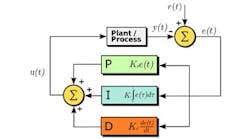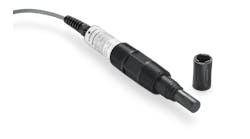The liquid composition response of each column tray is an interactive time constant (lag) where compositions on the trays above and below the tray affect the respective tray. Since a typical distillation column has 50 or more trays, the resulting interactive distributed lag system has a liquid composition response time in hours. Large columns may take more than a shift to reach steady state. When compositions are controlled at the top and bottom of the column (dual composition control) can result in oscillations. Furthermore, the precision of composition control required is extreme. Temperature is often used as an inferential measurement of composition because of the vapor liquid equilibrium or more simply stated as the change in boiling point with the mixture of component concentrations. Sometimes at-line analyzers trim the setpoint point and a pressure measurement is used to correct the temperature setpoint (e.g. effect of pressure on boiling point). If we exclude for the moment pressure control we have 4 controlled variables and 4 manipulated variables in a basic column. The principal controlled variables are top temperature and bottom temperature, overhead distillate receiver level, and column bottom sump level. The manipulated variables are reflux liquid flow (L), vapor flow (V), distillate flow (D), and bottoms flow (B). L is the liquid returned to the column top. V is the vapor boilup from the column bottom usually via steam to a reboiler. D is distillate flow from the overhead receiver to the next unit operation. B is the bottoms flow from column sump to the next unit operation. Column temperature is lowest at the top where the lighter light key component concentration is the greatest. Pressure is usually controlled by manipulating nitrogen and vent flow or condenser duty but in some cases by manipulating reflux flow. Side draws to eliminate a light key component in the bottoms composition create additional manipulated variables. Changes in L to control the top composition and changes in V to control the bottom composition have similar effects at each end of the column producing large relative gains. This is especially aggravated by the high reflux ratios in high purity distillation columns.
Also Read "7 Part Series on Distillation Control and Optimization"
Greg: First let me say that I am impressed with the Relative Gain Array (RGA). Engineering units, nonlinearities, and factors common to numerator and denominator of the relative gain do not affect the relative gain value. For a 2x2, you only need to identify one relative gain since the rows and columns must add up to one. There are many other key characteristics of RGA explained by Shinskey in his Chapter on Interaction and Decoupling in his 4th Edition of Process Control Systems. I am always amazed whenever I go to this book at the depth and scope of practical knowledge particularly in terms of the impact of process and equipment design and chemical engineering principles on process control. Strangely enough most of his books are out of print since publishers have no concept of the expertise and significance of the material documented. Many of my books have suffered a similar fate. For a while UMI provided reprints of essential books including the extraordinary Determination of pH Theory and Practice by R.G. Bates. Now you have to find a library that has a copy. Fortunately Momentum Press has put several of my books back in print such as Axial and Centrifugal Compressor Control. Enough of a digression relegated to the online version. Sigifredo solved the interaction problem for dual composition control in high purity benzene and toluene columns paring the controlled and manipulated variables with relative gains closest to unity. The original control scheme for the benzene column used an LV dual composition control strategy where the top composition was controlled by manipulating the reflux flow (L) and the bottom composition was controlled by manipulating the steam flow and thus the vapor flow (V). A delta temperature between trays 41 and 45 trays (counting from the bottom up) was used as an inferential measurement of the top composition and tray 9 temperature was used an inferential measurement of bottom composition. Only the bottom composition control was in service for the toluene column by the use of a bottom temperature getting a setpoint from an at-line Near Infrared (NIR) analyzer and a Single Input Single Output (SISO) Model Predictive Control (MPC) application. What are the distinguishing characteristics and challenges of high purity columns?
Sigifredo: The logarithmic behavior observed in the relationship between composition and temperature is accentuated in the high purity distillation columns, and it's been suggested that their control is beyond conventional feedback control. The response times can be so long that it can be very difficult to obtain a clear response even to a step change in a given manipulated variable. The interaction between top and bottom composition makes the LV dual composition control prone to severe oscillation, and very sensitive to enthalpy disturbances.
Stan: What was the final control scheme for the two columns arrived at by the use of a 2x2 RGA?
[sidebar id="2"]
Sigifredo: In the final configuration for the benzene column, the bottom product benzene impurities composition is controlled by a pressure compensated tray 9 temperature PID manipulating the side draw flow to feed flow ratio. The distillate receiver and column sump level are controlled by manipulating the reflux flow and bottoms flow respectively. Pressure is controlled by manipulating a vent valve and nitrogen inflow. The boilup is set by toluene overhead vapor flow of a heat exchanger for heat integration.
For the toluene column, the top composition is controlled by the tray 65 temperature PID manipulating the total draw to feed flow ratio. The total draw is balanced is between the side draw and distillate flows. Bottom composition is controlled by a temperature PID on the bottoms flow by manipulating the steam to feed flow ratio. Since the column operates with a flooded overhead receiver, pressure control is done by manipulating reflux flow in order to close the material balance. Column sump level was controlled by manipulating bottoms flow.
A feedforward of feed flow completes the temperature controllers on both columns.
Greg: What do you use to find the tray with the greatest sensitivity for an inferential measurement of composition? We use steady state process simulators confirmed by plant tests on new and existing columns to find the tray with the largest and most symmetrical change in temperature for changes in the manipulated variable (greatest sensitivity for positive and negative changes). We use the knowledge to take advantage of extra thermowell connections in the section of the column that provides the best indication of column performance. Do you do this before or after developing the RGA?
Sigifredo: My experience working in process control in general, and in distillation control in particular, has been with units that are in commercial operation. You don't get to choose where the sensors should be located, especially when it comes to the modification of a pressurized vessel; in consequence I have always used what is available and look for the best temperature or differential temperature I can use in order to implement the control strategy. I have frequently used steady state simulation results in order to check the viability of using the existing temperature sensors as a composition surrogates, though. This exercise is independent of the RGA analysis so I do it whenever I have that information readily available.
Stan: I understand you were able to reduce the 5x5 RGA down to a 2x2 RGA by removing inventory control (e.g. pressure and level control) from the interaction analysis. Does this also imply inventory loops should be tuned first? Is pressure control tuning always tight? The control of distillate receiver level by manipulation of reflux must be tight to enforce the material balance in the column. However, the level control of volumes where the manipulated flow is going to other unit operations should be tuned like a surge tank to minimize feed upsets to the unit operation downstream. Was this the case for the benzene and toluene sump level?
Sigifredo: Yes, the inventory control loops are tuned first. Distillation towers are sensitive to pressure variations, the tighter the pressure control tuning the better the performance and better stability in the tower composition profile in general. The benzene and toluene column bottom level were tuned to attain averaging level control by using a proportional only controller with a gain higher than unity just enough to keep the level within bounds.
Greg: In columns with high purity feeds, the distillate or bottoms flow of the impurity removed can be too small to control the overhead receiver or column sump level. In this case the inventory control requires the use of reflux or steam flow for the control of the overhead receiver and column sump level, respectively. Steam flow is a last choice for the control of level because of the inverse response created from steam bubbles in the reboiler.
Stan: Why is the temperature on the benzene column pressure compensated but the temperature on the toluene column is not?
Sigifredo: The pressure compensated temperature didn't work in the toluene column because the pressure and temperature sensors were located too far apart making the control oscillatory.
Greg: If the relative gains and sensitivities are about the same, would you choose the pairing with the least deadtime or is this rarely a consideration?
Sigifredo: Proper tuning is capable of removing interaction when there is a sizeable difference between the dynamics of the control loops, so it is a sound procedure to pair loops based on the speed of response. So far, whenever I have used Shinskey's RGA distillation column control methodology I have never run into a case where the dynamic behavior supersedes the RGA analysis. The occasions when I changed an RGA recommended strategy, it was following process related issues rather than time delay.
Greg: It appears the delta temperature control was not used for a number of practical reasons in the toluene column most notably the concave downward curve (plot of differential temperature versus impurity concentration) with a reversal of process gain as you move from one side to the other of the peak. Is this concave downward curve a common problem?
Sigifredo: Delta temperature control is a problem when the neighboring trays have different steady state compositions that can reverse. If the reversal is likely to occur when the column is pushed to high production rates by high steam flow rates, delta temperature cannot be used as a composition surrogate. I have successfully used this delta temperature concept is other high purity distillation column applications.
Greg: The NIR analyzers were not used in the final solution. In previous Control Talk columns “Gas Chromatographs Rule” and “Process Analyzers. Analyze This!” specialists did not have a favorable view of NIR. Are there long term issues with maintainability, selectivity, and signal to noise ratio? Did the plant use the NIR analyzers to manually correct temperature setpoints or diagnose process problems or anything else to justify their existence? The concern is that while NIR may do well on the samples used to develop the calibration, changing conditions in the field may reduce selectivity and increase noise. Also, the calibration requires special expertise in statistical analysis of spectrums. Have you seen NIR used elsewhere for closed loop control?
Sigifredo: In this particular application the small signal to noise ratio of the NIR analyzer measuring the toluene content at the top of the xylene tower caused unnecessary moves in the temperature surrogate inference controller. The facility opted for a temperature setpoint reset based on a daily lab test instead. I have seen NIR being used in closed loop applications where the composition values are not in the fractions of a percent.
Stan: When you tuned the inferred composition (temperature) controllers, how did the recognition that the process was distributed interactive lags (e.g. tray composition and energy material balance response) affect the identification of dynamics and the computation of the tuning settings used? Did you still end up with a first order plus dead time or second order plus dead time model as the net result of distributed lags?
Sigifredo: First order plus deadtime or a reaction curve is always good enough to tune a loop, and it works fine with processes that are distributed interactive lags as well; a second order plus dead time would be even better, but it requires system identification software tools that are not normally available. I can get pretty good performance from “educated guess” or “know-how” closed loop tuning whenever is required. However the behavior of the control tray temperature below the feed tray used in the benzene tower to control the impurities in the bottom product had to be modeled as distributed interactive lags in order to accomplish good and robust performance. I used the tuning rules developed by Shinskey that minimize the absolute integrated error (IAE) of a step load disturbance for a distributed process. However, I use practical experience to provide settings that provide more robustness.
Greg: The tuning rules on page 55 of the 4th Edition of Process Control Systems give a PID gain that is about 40% lower and a reset time that is 20% higher than the settings based on minimizing the IAE from a load disturbance for a pure single time constant and dead time in Table 1.1 on page 38 (table tuning settings interpolated for an equivalent pure dead time to time constant ratio of 0.14 based on entries of 0.1 and 0.2 for dead time to time constant ratios). Tuning settings for minimum IAE have a narrow stability margin. Minimum IAE settings become oscillatory due to the inevitable changes in the actual dynamics and errors in the identified dynamics. The next column provides guidance on how to improve settings for industrial applications.
Stan: Does the RGA based distillation methodology always provide the right answers in providing the proper recommendation for a dual or single composition control?
Sigifredo: The calculations use a separation model. Models are not the reality, and there is no magic in any software application as some have come to believe. A tool can support know-how, but it will never replace it. I have run into many other instances where the control strategy needs to be though out, based on hands-on experience. Process rules!
Greg: Have you used RGA on applications other than distillation column control?
Sigifredo: I have used RGA to assess the degree of interaction or assign loop pairing in other processes, as well as to calculate the degree of detuning that may be required in order to maintain good performance in spite of the coupling.
Greg: To continue our interaction theme we look at the interactions between pros and cons in a career in process control.
Top 10 Pros and Cons of a Career in Process Control
10. Pro: You realize controllers transfer variability from the controlled variable to the manipulated variability. Con: Operators ask you to keep the controlled variable and manipulated variable constant.
9. Pro: You understand as you decrease the measurement lag control is tighter for flow and pressure loops. Con: Operators are upset when you install a faster transmitter because of less filtering of the real world.
8. Pro: You recognize the source of limit cycles. Con: you cannot buy cheap piping valves for throttling.
7. Pro: You become proficient at tuning PID controllers and using feedforward control. Con: You don't get recognition for applying model predictive control.
6. Pro: You spend your whole career learning and using technology. Con: You have a cubicle rather than an office and you don't get to set raises and promotions.
5. Pro: You have a collection of the best current books on process control. Con: None of the books are nearly as good as the ones out of print.
4. Pro: Your Company reports record profits. Con: The gains were achieved by eliminating technical and maintenance support.
3. Pro: A DCS upgrade project was approved that offers the latest tools for process control improvement. Con: The migration project is a copy job.
2. Pro: You know what it takes to simplify and optimize systems. Con: The complexity of legislation and the inefficiency of government are more baffling than ever.
1. Pro: You use logic to understand cause and effect in process relationships. Con: Logic does not work in understanding spouse.






